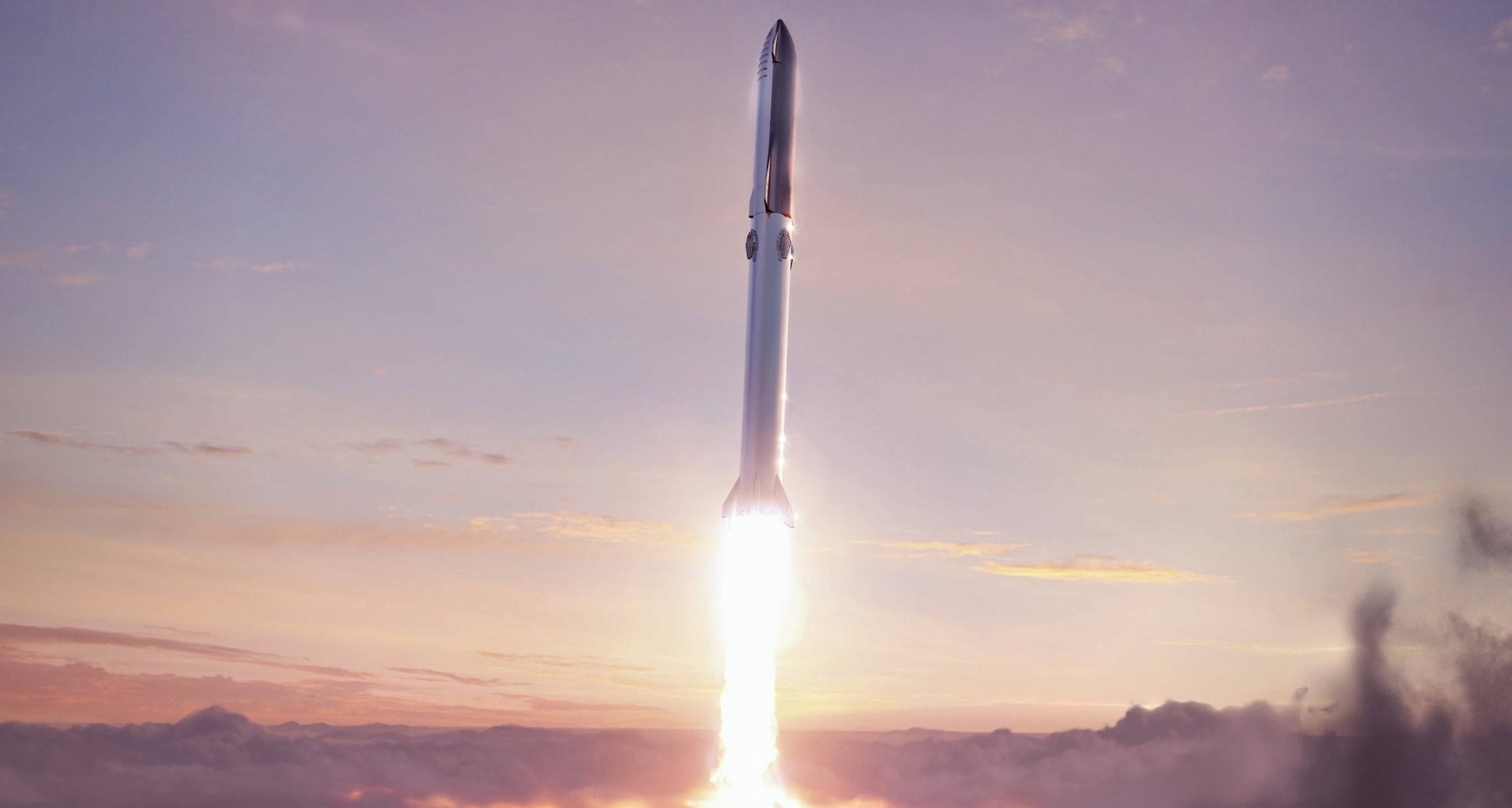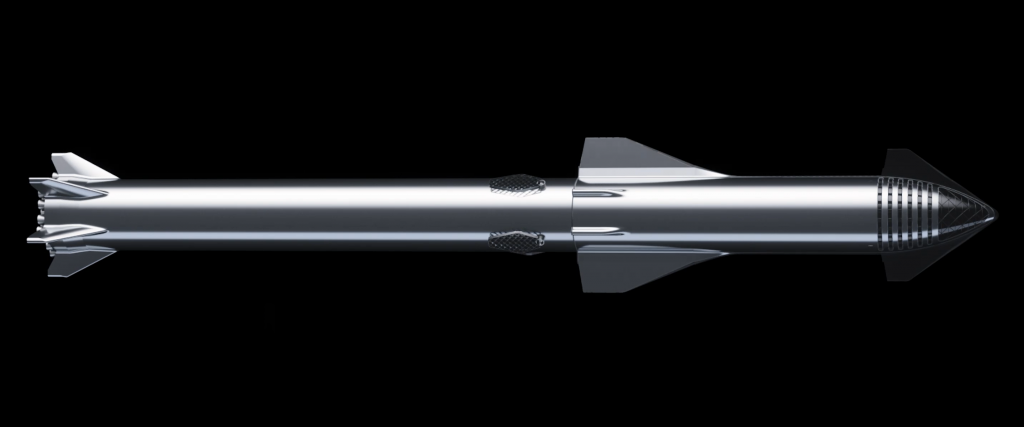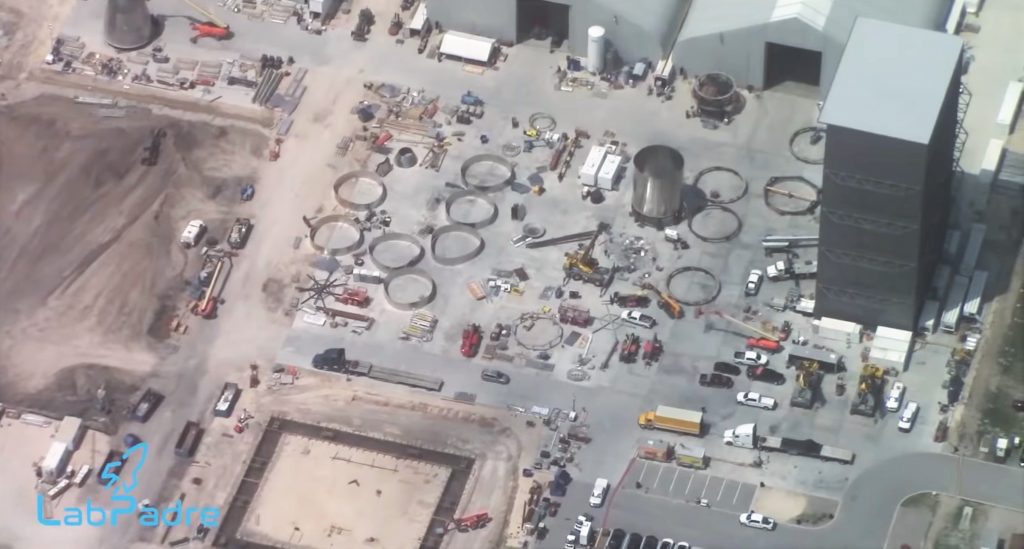

News
SpaceX’s Starship Super Heavy booster needs a custom assembly tower
SpaceX CEO Elon Musk has confirmed that Starship’s Super Heavy rocket booster will get its own tower-like vehicle assembly building (VAB) – and work on the structure may have already begun.
While the only visible work SpaceX has thus far completed on its next-generation Starship launch vehicle is related to the more complex and unproven upper stage of the rocket, its Super Heavy first stage (booster) is just as critical. For SpaceX, Starship was the perfect starting point, itself following on the footsteps of a largely successful multi-year Raptor engine development program. Substantially smaller than Super Heavy and requiring 5-10 times fewer engines, Starship serves as a testbed for an almost entirely new suite of technologies and strategies SpaceX is employing to build massive rockets out of commodity steel.
In recent months, particularly following the first successful pressure test of a full-scale Starship tank section in April, SpaceX has effectively proven that those uncharacteristically cheap and simple materials and methods can, in fact, build rocket structures that should stand up to orbital spaceflight. In theory, aside from the booster’s 31-engine thrust structure, the same methods and materials used to build Starships can be applied unchanged to manufacture Super Heavy. The booster’s almost unfathomable size, however, will necessitate its own dedicated assembly facilities.

While Starship itself is not exactly small at ~50m (165 ft) tall and 9m (30ft) wide, the Super Heavy booster tasked with launching the ship on its way to orbit will easily be the largest individual rocket stage ever built. Currently expected to measure 70m (230 ft) tall, Super Heavy – just the first stage of the Starship launch vehicle – will already be as tall as an entire Falcon 9 or Falcon Heavy and weigh roughly three times more than the latter triple-booster rocket when fully fueled. At liftoff, Super Heavy will produce more than triple the thrust of Falcon Heavy and double the thrust of Saturn V, the most powerful liquid-fueled rocket to reach orbit.


Thanks to the sheer size of the booster, SpaceX’s existing Starship-sized vehicle/vertical assembly building (VAB) is far too small for Super Heavy and is even too short to fully stack a ~50m Starship. SpaceX’s contractor of choice started assembling that VAB around January 15th and the facility was able to begin supporting its first Starship stacking and welding operations on March 2nd, just a month and a half later, with the structure fully completed by March 18th. As such, assuming the in-work foundation is as close to completion as it seems and SpaceX uses the same contractor for the next building, Super Heavy’s VAB could be ready to build the first massive booster prototype as early as July or August. Things could take a bit longer given that Musk says the booster VAB will be 81m (265 ft) tall, nearly twice the height of Starship’s VAB, but likely by no more than a few weeks.
That timeline meshes well with a senior SpaceX engineer and executive’s recent suggestion that the first orbital Starship launch attempt could still happen before the end of the year. Of course, for Super Heavy to become a genuine priority for SpaceX and receive the resources necessary to achieve that extremely ambitious goal, Starship will have to perform almost flawlessly during a series of increasingly challenging tests planned over the next few months. First up, SpaceX needs to finish repairing the launch pad after Starship SN4 exploded during testing and Starship SN5 needs to be transported to the pad to complete acceptance tests, static fire(s), and its first 150m (~500 ft) hop test. After that, SpaceX will either move on to a 2 km (1.25 mi) hop or a more ambitious 20 km (12.5 mi) flight designed to test Starship’s skydiver-like approach to landing.
If Starship SN5 or SN6 manage to complete those aforementioned tests, the horse may actually be in front of the cart for Super Heavy prototype production and Starship’s first orbital launch attempt.
Check out Teslarati’s Marketplace! We offer Tesla accessories, including for the Tesla Cybertruck and Tesla Model 3.
Elon Musk
Tesla investors will be shocked by Jim Cramer’s latest assessment
Jim Cramer is now speaking positively about Tesla, especially in terms of its Robotaxi performance and its perception as a company.

Tesla investors will be shocked by analyst Jim Cramer’s latest assessment of the company.
When it comes to Tesla analysts, many of them are consistent. The bulls usually stay the bulls, and the bears usually stay the bears. The notable analysts on each side are Dan Ives and Adam Jonas for the bulls, and Gordon Johnson for the bears.
Jim Cramer is one analyst who does not necessarily fit this mold. Cramer, who hosts CNBC’s Mad Money, has switched his opinion on Tesla stock (NASDAQ: TSLA) many times.
He has been bullish, like he was when he said the stock was a “sleeping giant” two years ago, and he has been bearish, like he was when he said there was “nothing magnificent” about the company just a few months ago.
Now, he is back to being a bull.
Cramer’s comments were related to two key points: how NVIDIA CEO Jensen Huang describes Tesla after working closely with the Company through their transactions, and how it is not a car company, as well as the recent launch of the Robotaxi fleet.
Jensen Huang’s Tesla Narrative
Cramer says that the narrative on quarterly and annual deliveries is overblown, and those who continue to worry about Tesla’s performance on that metric are misled.
“It’s not a car company,” he said.
He went on to say that people like Huang speak highly of Tesla, and that should be enough to deter any true skepticism:
“I believe what Musk says cause Musk is working with Jensen and Jensen’s telling me what’s happening on the other side is pretty amazing.”
Tesla self-driving development gets huge compliment from NVIDIA CEO
Robotaxi Launch
Many media outlets are being extremely negative regarding the early rollout of Tesla’s Robotaxi platform in Austin, Texas.
There have been a handful of small issues, but nothing significant. Cramer says that humans make mistakes in vehicles too, yet, when Tesla’s test phase of the Robotaxi does it, it’s front page news and needs to be magnified.
He said:
“Look, I mean, drivers make mistakes all the time. Why should we hold Tesla to a standard where there can be no mistakes?”
It’s refreshing to hear Cramer speak logically about the Robotaxi fleet, as Tesla has taken every measure to ensure there are no mishaps. There are safety monitors in the passenger seat, and the area of travel is limited, confined to a small number of people.
Tesla is still improving and hopes to remove teleoperators and safety monitors slowly, as CEO Elon Musk said more freedom could be granted within one or two months.
News
Tesla launches ultra-fast V4 Superchargers in China for the first time
Tesla has V4 Superchargers rolling out in China for the first time.

Tesla already has nearly 12,000 Supercharger piles across mainland China. However, the company just initiated the rollout of the ultra-fast V4 Superchargers in China for the first time, bringing its quick-charging piles to the country for the first time since their launch last year.
The first batch of V4 Superchargers is now officially up and running in China, the company announced in a post on Chinese social media outlet Weibo today.
The company said in the post:
“The first batch of Tesla V4 Superchargers are online. Covering more service areas, high-speed charging is more convenient, and six-layer powerful protection such as rain and waterproof makes charging very safe. Simultaneously open to non-Tesla vehicles, and other brands of vehicles can also be charged. There are more than 70,000 Tesla Superchargers worldwide. The charging network layout covers 100% of the provincial capitals and municipalities in mainland China. More V4 Superchargers will be put into use across the country. Optimize the charging experience and improve energy replenishment efficiency. Tesla will accompany you to the mountains, rivers, lakes, and seas with pure electricity!”
The first V4 Superchargers Tesla installed in China are available in four cities across the country: Shanghai, Zhejiang, Gansu, and Chongqing.

Credit: Tesla China
Tesla has over 70,000 Superchargers worldwide. It is the most expansive and robust EV charging network in the world. It’s the main reason why so many companies have chosen to adopt Tesla’s charging connector in North America and Europe.
In China, some EVs can use Tesla Superchargers as well.
The V4 Supercharger is capable of charging vehicles at speeds of up to 325kW for vehicles in North America. This equates to over 1,000 miles per hour of charging.
Elon Musk
Elon Musk hints at when Tesla could reduce Safety Monitors from Robotaxi
Tesla could be reducing Safety Monitors from Robotaxi within ‘a month or two,’ CEO Elon Musk says.

Elon Musk hinted at when Tesla could begin reducing Safety Monitors from its Robotaxis. Safety Monitors are Tesla employees who sit in the front passenger seat during the driverless rides, and are there to ensure safety for occupants during the earliest rides.
Tesla launched its Robotaxi fleet in Austin last Sunday, and after eight days, videos and reviews from those who have ridden in the driverless vehicles have shown that the suite is safe, accurate, and well coordinated. However, there have been a few hiccups, but nothing that has put anyone’s safety in danger.
A vast majority — close to all of the rides — at least according to those who have ridden in the Robotaxi, have been performed without any real need for human intervention. We reported on what was the first intervention last week, as a Safety Monitor had to step in and stop the vehicle in a strange interaction with a UPS truck.
Watch the first true Tesla Robotaxi intervention by safety monitor
The Tesla and UPS delivery truck were going for the same street parking space, and the Tesla began to turn into it. The UPS driver parallel parked into the spot, which was much smaller than his truck. It seemed to be more of an instance of human error instead of the Robotaxi making the wrong move. This is something that the driverless cars will have to deal with because humans are aggressive and sometimes make moves they should not.
The Safety Monitors have not been too active in the vehicles. After all, we’ve only seen that single instance of an intervention. There was also an issue with the sun, when the Tesla braked abnormally due to the glare, but this was an instance where the car handled the scenario and proceeded normally.
With the Robotaxi fleet operating impressively, some are wondering when Tesla will begin scaling back both the Safety Monitors and Teleoperators that it is using to ensure safety with these early rides.
CEO Elon Musk answered the inquiry by stating, “As soon as we feel it is safe to do so. Probably within a month or two.”
As soon as we feel it is safe to do so.
Probably within a month or two. We continue to improve the Tesla AI with each mile driven.
— Elon Musk (@elonmusk) June 30, 2025
Musk’s response seems to confirm that there will be fewer Teleoperators and Safety Monitors in the coming months, but there will still be some within the fleet to ensure safety. Eventually, that number will get to zero.
Reaching a point where Tesla’s Robotaxi is driverless will be another significant milestone for the company and its path to fully autonomous ride-sharing.
Eventually, Tesla will roll out these capabilities to consumer-owned vehicles, offering them a path to generate revenue as their car operates autonomously and completes rides.
For now, Tesla is focusing on perfecting the area of Austin where it is currently offering driverless rides for just $4.20 to a small group of people.
-

 News5 days ago
News5 days agoTesla Robotaxi’s biggest challenge seems to be this one thing
-

 News2 weeks ago
News2 weeks agoTesla confirms massive hardware change for autonomy improvement
-

 Elon Musk2 weeks ago
Elon Musk2 weeks agoElon Musk slams Bloomberg’s shocking xAI cash burn claims
-

 News2 weeks ago
News2 weeks agoTesla features used to flunk 16-year-old’s driver license test
-

 News2 weeks ago
News2 weeks agoTesla China roars back with highest vehicle registrations this Q2 so far
-

 News2 weeks ago
News2 weeks agoTexas lawmakers urge Tesla to delay Austin robotaxi launch to September
-

 News2 weeks ago
News2 weeks agoTesla dominates Cars.com’s Made in America Index with clean sweep
-

 News2 weeks ago
News2 weeks agoTesla’s Grok integration will be more realistic with this cool feature


















